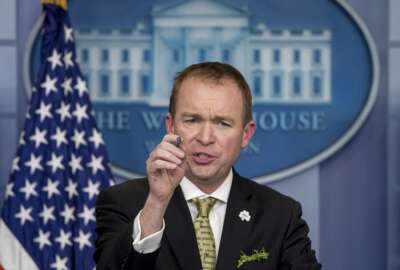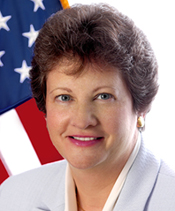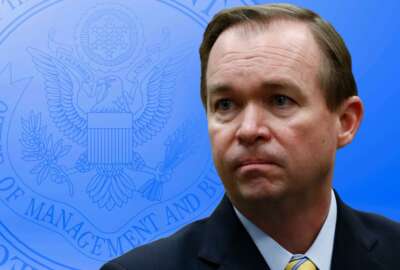

Linda Springer, a senior adviser at OMB, said the Trump administration is borrowing from past administrations and modifying many long-held concepts to reorganize...
This is part 1 of Federal News Radio’s exclusive interview with OMB Senior Adviser Linda Springer about the development, expectations and potential impact of the reorganization memo. In part 2, Springer discussed why federal employees should look at the reorganization as an opportunity and not as a workforce-cutting exercise.
In many ways, the Office of Management and Budget’s bold plan to reshape the federal government is like a reboot of an old movie. The story line is similar, but the approach and style are updated to meet today’s audience’s expectations.
Linda Springer, a senior adviser at OMB, said the Trump administration is borrowing from past administrations and modifying many long-held concepts to reorganize and restructure the government.

Springer, who came to the administration in February after working on the transition team, said the OMB career staff deserves a lot of credit for developing implementation guidance, released April 12, for both the executive order to reorganize the government and the hiring freeze memo.
“We have a very seasoned team at OMB on the management side, and once the executive order came out about the restructuring, combined with the presidential memorandum about the freeze, we got to work, and I was privileged as the primary political appointee to work with the OMB management career team and start to think about how we would put together the direction that would go with both of those items,” Springer said in an exclusive interview with Federal News Radio. “By having all the different career offices being part of the drafting and thoughtfulness about this, we were able to have a pretty wide, comprehensive list of tools that are available, and whether its shared services or best-in-class or category buying or any of those kinds of things, as well as the various technology items to look at, workforce, the full spectrum are things that we wanted to remind the agencies of, because OMB is not micro-managing the process, particularly in that first phase between now and June 30 was to incent or encourage the agencies to think very broadly and very expansively and to think about all of these different techniques and tools that we reminded them of in this guidance.”
Springer said the career staff input is one main reason the memo includes everything from shared services, to insourcing contractor jobs, to outsourcing federal jobs to consolidating office space.
In fact, Springer said no idea was “off-the-table” when OMB developed the memo. She said the goal was to include anything and everything that agencies could take advantage of to improve the effectiveness and efficiency of the government.
“As you could imagine, many of us have gotten ideas, white papers from people outside of the agencies, advisers, good-government groups, people have called us. We are meeting with the councils— we met with the CFO Council [April 19]— all of these are various audiences that are very excited about the opportunity to share their ideas,” she said. “It validates this is something people have thought about for years and now feel that they have permission to think broadly and put those ideas out.”
Springer said the Trump administration wants to make the goal of the restructuring effort clear.
“We’ve been very careful to position this as a good-government initiative, a more effective government initiative,” she said. “It’s not tied to a particular ideology or a place on the political spectrum. It really is intended to make government work better.”
This is why OMB Director Mick Mulvaney said at the April 11 briefing with reporters that agencies can make their case for increases in staffing or budget.
OMB’s memo does not detail specific agency reductions or cuts. But it describes how agencies should identify programs and personnel that are duplicative or non-essential — or whether they can be merged with other functions or departments.
“It’s wrong to paint with a broad brush and say, because we are going to be reducing the overall size of government as part of this consistent with our budget, that that means that everybody should just focus on who’s getting fired,” Mulvaney said. “That’s the wrong message to take from this. The right message is, we’re trying to figure out a way to make the government more responsive and more accountable, and that means taking care of the people who are doing a good job.”
Springer said OMB wants agencies to look at restructuring down to the mission areas or components, and some specific areas could end up growing despite an overall reduction in budget or personnel at the department.
“It may be as simple as looking at offices or branches and things that are geographically disbursed to see where there may be management or back-office functions that are duplicative,” she said. “Or maybe at one point in time it made sense to have a localized procurement function somewhere in the country, but now it can be handled in a centralized way. There is not one-size-fits-all. There are no quotas. It is not ‘X’ percentage of change one way or another. This is really supposed to be thoughtful, and where the workforce design follows the restructuring of the mission and the activities of the mission.”
Federal employees seem to be slowly warming to the idea of reorganization. A Federal News Radio survey of 750 readers found a third of the respondents supported the idea of a reorganization, but disagreed with OMB’s approach, while another 17 percent said they both supported the concept of restructuring and agreed with OMB’s approach.
More respondents — nearly 26 percent — said it’s too early to predict how the reorganization might impact them, while another 16 percent said OMB’s restructuring plan is reflective of previous attempts to reorganize. Many federal employees said their agency had already gone through some sort of reorganization before with mixed results.
Springer said OMB will work with agencies between now the September to develop plans and provide feedback. She said the initial plans due by June 30 will be a high-level set of ideas and vision for the future of the agency.
“OMB also will be working very closely on looking at cross-cutting, cross-agency types of issues. There are many of those that span across agencies and where things like shared services could ultimately come into play as a solution,” she said. “Beyond the June 30 point, there will be a set of conversations between OMB, particularly the resource management offices (RMOs) on the budget side that really have insight into the functioning of the agency by virtual of the budget process. There will be conversations in lieu of the stat conversations we typically have in that period. Those will become a point where things become refined and there is a deeper look and more specificity around what those agency restructuring plans could look like.”
All of these efforts come together in the fiscal 2018 budget request in September.
Springer said the RMOs and examiners have been involved in the drafting and commenting of the guidance.
“As far as the process going forward, it’s obviously a whole of OMB involvement,” she said. “We will have our assignments. We actually met as recently as [April 18] to think about how we can calendarize all of those various assignments so there is clarity around what the expectations are and when those different things can occur.”
Copyright © 2025 Federal News Network. All rights reserved. This website is not intended for users located within the European Economic Area.
Jason Miller is executive editor of Federal News Network and directs news coverage on the people, policy and programs of the federal government.
Follow @jmillerWFED


